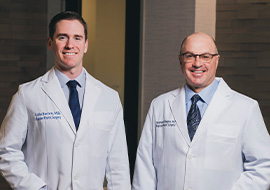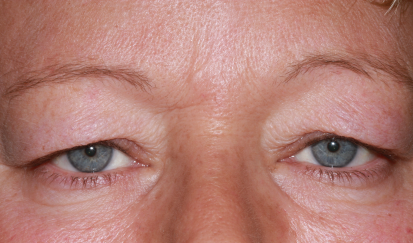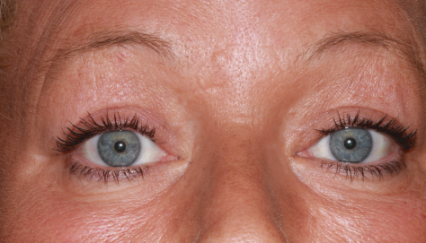Common Questions
What cosmetic services are available at Klapper Eyelid & Facial Plastic Surgery? How many days do I need to take off work following my surgery? How long does it take to heal after surgery? How long will I be bruised and swollen following my surgery? When can I wear make-up, wash my hair, or shower following my surgery? When can I return to exercising after surgery?
Blepharoplasty Surgery
What is Blepharoplasty Surgery?
Eyelid surgery to remove or reposition redundant tissues in the upper or lower eyelid is referred to as “blepharoplasty”. Upper eyelid blepharoplasty involves removal of skin, muscle, and/or fat and is one of the most common cosmetic surgical procedures performed in the United States. Functional upper eyelid blepharoplasty is performed to help restore the superior field of vision that is significantly impaired by the redundant upper eyelid tissues. Lower eyelid blepharoplasty is nearly always considered cosmetic and emphasizes removal and/or repositioning of the lower eyelid fat (“fat bags”). Blepharoplasty Surgery is different than Ptosis Surgery which is performed to raise or elevate a droopy upper eyelid.
 Watch to learn more about Blepharoplasty Surgery
Watch to learn more about Blepharoplasty Surgery
Functional Blepharoplasty
As one ages, the upper and lower eyelid tissues begin to relax. These non-specific changes may be accelerated by sun exposure , allergies or recurrent swelling that result in stretching of the skin. In some individuals, this process may be hereditary or ‘run in the family’. Excess eyelid tissue is referred to as “dermatochalasis”. Stretching and relaxation of the orbital septum (the middle layer of the eyelid) allows orbital fat to move forward. As a result, a “fullness” to the eyelid develops. With time, the excess eyelid tissues in the upper eyelid may hang over the eyelid margin and cause a superior visual field restriction. If this restriction is significant enough to meet specific criteria established by insurance carriers and Medicare, then upper eyelid blepharoplasty may be a covered reconstructive procedure. Surgical removal of the excess skin, muscle, and fat (if needed) may lead to an improved and more comfortable field of view.
Cosmetic Blepharoplasty
Your eyes are often the first thing people notice about your face and are an important aspect of facial attractiveness. Unfortunately, with aging, the upper and lower eyelids become “droopy” or “baggy” in appearance. Excess eyelid tissue may create a tired look, a heavy feeling to the eyelid area, and may make patients look and feel older. Aesthetically, such conditions may detract from the overall attractiveness of one’s eyes. Removal of the excess skin and fat from either or both the upper and lower eyelids can restore a younger, more rested facial appearance.
The goal of blepharoplasty surgery is to remove and/or reposition excess eyelid skin and fat. In doing so, patients often look more alert and healthy, less tired, and generally have a younger, more rested upper facial appearance. It is important for patients to understand that although they will look better and may feel better about themselves, they should not expect their lives to change dramatically.
What to Expect from an Eyelid Consultation
A preoperative comprehensive eye examination is essential to document a patient’s visual acuity, tear film stability, strength of eyelid closure, symmetry of palpebral fissures (eyelid height), previous eyelid surgery, etc. For those considering surgery for functional reasons, a visual field test (with the eyelids relaxed and elevated) is required. Preoperative photos are routinely performed prior to both functional and cosmetic blepharoplasty.
Patients considering cosmetic eyelid surgery need to discuss with an experienced eyelid surgeon what they want to achieve from a blepharoplasty. Blepharoplasty is able to remove the bulges created by fat herniation and remove excess skin that is becoming redundant. Skin discoloration, deep creases, and cheek fullness are not corrected by eyelid surgery. Patients also need to know that enough skin has to remain after surgery to allow proper eyelid closure. Blepharoplasty surgery can not remove “all” the fine lines in the eyelid.
Many patients also have a droopy eyebrow which must be addressed when considering upper eyelid surgery. Brow tissue often descends into the outer eyelid area and patients should be aware of how “heavy brows” may be contributing to the redundant tissue in the eyelid area. Brow and Forehead Lifting procedures may be necessary at the time of blepharoplasty surgery to achieve a patient’s periorbital aesthetic goals.
Does Insurance Cover Eyelid Surgery?
There are certain criteria that must be satisfied for most insurance carriers, as well as Medicare to pay for part or all of your eyelid surgery. For any health care plan to cover surgery, a patient’s eyelids must significantly restrict the superior field of vision resulting in some limitation of daily activities such as reading, writing, driving, sewing, etc. Standardized photographs must be submitted and demonstrate significant narrowing of eye opening with a diminished distance from the upper eyelid to the light reflex (near the center of the pupil). Visual fields may also be required to further document constriction of the superior field. Visual fields are performed with the eyelids at rest and with the eyelids elevated to demonstrate the improvement expected with surgery. The amount of restriction present and improvement seen with eyelid taping or elevation that insurance companies require to provide coverage varies between insurance carriers. The predetermination process for commercial insurance may take 3-4 weeks or longer to complete. Lower eyelid blepharoplasty surgery is rarely covered by insurance or Medicare and is considered cosmetic in almost all cases.
What Is Different about Medicare Coverage?
Medicare does not pay for everything. With Medicare, the decision to cover surgery is not made until after surgery when the claim(s) are submitted from the doctor’s office and surgical facilities. Traditional Medicare does not have a pre-approval (predetermination) process for eyelid surgery. Some Medicare replacement policies may have pre-approval policies that are similar to standard commercial carriers. Dr. Klapper or Dr. Bacorn will discuss with you whether your standardized facial photographs and/or visual fields may, in his opinion, meet the specific criteria outlined by the local carrier for Medicare. We can not, however, guarantee whether your surgery will be a covered service. Lower eyelid blepharoplasty surgery is considered cosmetic in almost all cases. A referral from your primary care physician or eye doctor does not ensure that Medicare will cover your eyelid surgery.
Medicare patients considering functional blepharoplasty and/or ptosis surgery may be asked to sign Medicare’s Advance Beneficiary Notice of Noncoverage (ABN) indicating that you understand your financial responsibility if Medicare does not cover your surgery. Similarly, Medicare patients electing to proceed with blepharoplasty, ptosis, or brow/forehead lifting procedures that do not appear to meet Medicare’s criteria for medical necessity will also be asked to sign Medicare’s Advance Beneficiary Notice of Noncoverage (ABN) indicating that the procedure(s) is(are) considered cosmetic, non-covered service(s) and will not be filed with Medicare. Secondary insurance carriers generally follow Medicare guidance.
Blepharoplasty – The Surgery
Blepharoplasty surgery is an out-patient procedure that may be performed under local anesthesia. Intravenous sedation with intraoperative anesthesia monitoring is often recommended for patients with other medical conditions or who prefer to not be awake during their procedure. Incisions are made in the natural folds of the eyelid (in the crease of the upper eyelid and just beneath the eyelashes in the lower eyelid) so they are well hidden after proper tissue healing.
Lower eyelid blepharoplasty is most frequently performed via a “transcutaneous” approach through a typically well-hidden incision just below the lower eyelid lash line. Tightening of the lower eyelid with fat excision and/or repositioning, with or without skin removal is meticulously performed to improve the lower eyelid appearance and tone and potentially smooth the lower eyelid-cheek junction. If only fatty tissue needs to be removed from the lower eyelids without any skin, then surgery can be performed from inside the eyelid. This is known as a “transconjunctival” blepharoplasty.
In cases where the eyebrow area is also droopy (brow ptosis), a procedure to elevate the eyebrow may be appropriate. A procedure known as a Brow Lift, may be done directly above the eyebrow, within the forehead creases, or at the hairline.. It is important to recognize that a droopy eyebrow may be contributing to the excess skin and fullness seen in the upper eyelids. Blepharoplasty surgery will not correct redundant tissue resulting from brow ptosis.
What to Expect After Eyelid Surgery
Following surgery, cold compresses (ice packs) and a topical antibiotic ointment are applied for 3 to 4 days followed by warm compresses beginning around day 5. Eye patching is not recommended. Discomfort is usually minimal and is typically handled by acetaminophen (Tylenol®). The eyelid blink rate also temporarily slows down following surgery leaving the eyes with a gritty or sandy feeling. Non-preserved artificial tears (ex/ Bion Tears, Refresh Plus, Refresh Celluvisc) should be instilled frequently (several times/day) to maintain eye lubrication. Lubricating eye ointment (ex/ Refresh PM, Systane Nighttime, Lacrilube) should be instilled nightly if incomplete eyelid closure is present. More frequent ocular lubrication is generally required for Ptosis patients than patients only undergoing blepharoplasty surgery.
Most individuals will have swelling and some degree of bruising that will gradually improve over the first 1 to 3 weeks and may take a few months to completely resolve. Patient healing, however, is variable with some individuals healing much quicker than others. Near complete tissue healing usually occurs by 3 to 4 months. The upper eyelids will have diminished sensation (and feel numb) for up to 6 months or more.
For upper eyelid blepharoplasty, 3 to 5 days off work is average while up to 8-10 days may be best for those patients having both an upper and lower eyelid blepharoplasty. Patient’s with occupations requiring minimal physical activity may return to work sooner than those that operate a motorized vehicle or perform heavy lifting or have concerns about visible signs of surgery in the workplace. Blurred vision at distance or while reading may last just a few days or take several weeks to return to baseline. Makeup can be applied to help hide residual bruising after 2 to 3 weeks. Contact lens wear is typically avoided during the first 3 weeks after surgery or until adequate blinking and eyelid closure returns.
Complications
As with any surgery, unanticipated challenges and complications can occur with eyelid surgery. Excessive pain, bleeding, and infection are uncommon. Severe loss of vision following surgery is rare (estimated to be around 1 in 2,000 cases). It may occur if deep orbital hemorrhage occurs. This typically would occur within the first 24 hours following surgery, so it important for patients to have a responsible adult with them the afternoon and evening following surgery. Inadequate lubrication of the eyes following surgery may also result in corneal scarring or infection causing vision loss. Patients must ensure that they will be able to return to see Dr. Klapper or Dr. Bacorn, as often as needed, during the first several days and weeks after surgery so that any problems or concerns that arise are followed closely and, if appropriate, treated promptly.
Once the healing process has settled (typically around 4-6 months), significant eyelid asymmetry requiring a touch-up surgical procedure is necessary in fewer than 3% of patients.
Summary
Patients considering blepharoplasty should assess their goals and expectations of surgery and discuss them with an experienced eyelid surgeon. The goal of blepharoplasty surgery is to remove and reposition excess skin and fat to provide functional and/or cosmetic improvement. Patients often look more alert and healthy, less tired, and generally have a younger, more rested appearance. A brow lift procedure is frequently necessary to adequately treat the redundant tissue of the upper eyelid area and achieve a patient’s goals. Most patients are quite pleased with the results of their eyelid surgery.
Upper Eyelid Blepharoplasty, Female, 52 years old
-
 Before
Before
-
 After
After
More information on Blepharoplasty Surgery
Common Questions
What cosmetic services are available at Klapper Eyelid & Facial Plastic Surgery? How many days do I need to take off work following my surgery? How long does it take to heal after surgery? How long will I be bruised and swollen following my surgery? When can I wear make-up, wash my hair, or shower following my surgery? When can I return to exercising after surgery?
Klapper Eyelid & Facial Plastic Surgery treats disorders, injuries, and other abnormalities of the eyelids, eyebrow, tear duct system, eye socket, and adjacent areas of the mid and upper face.
